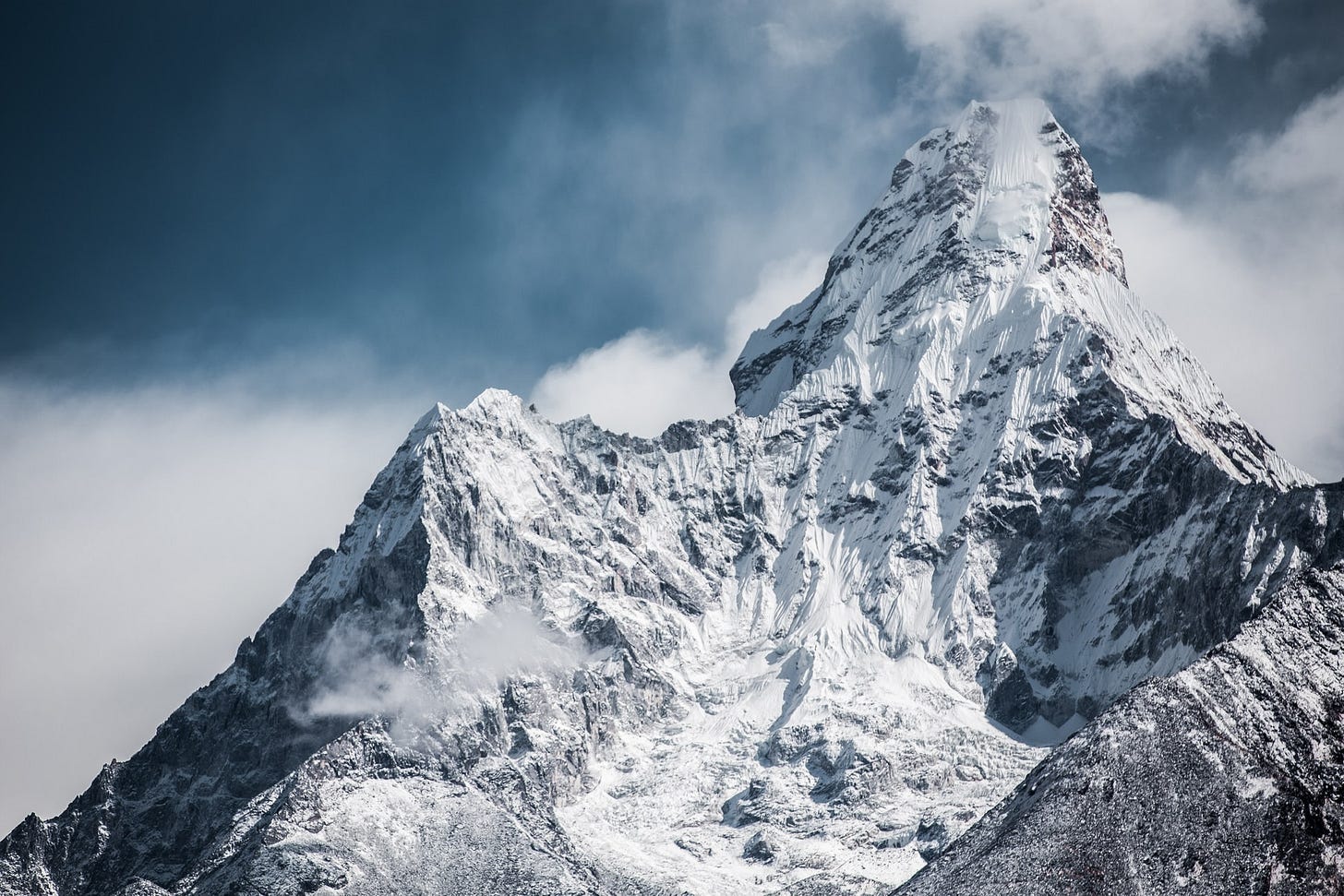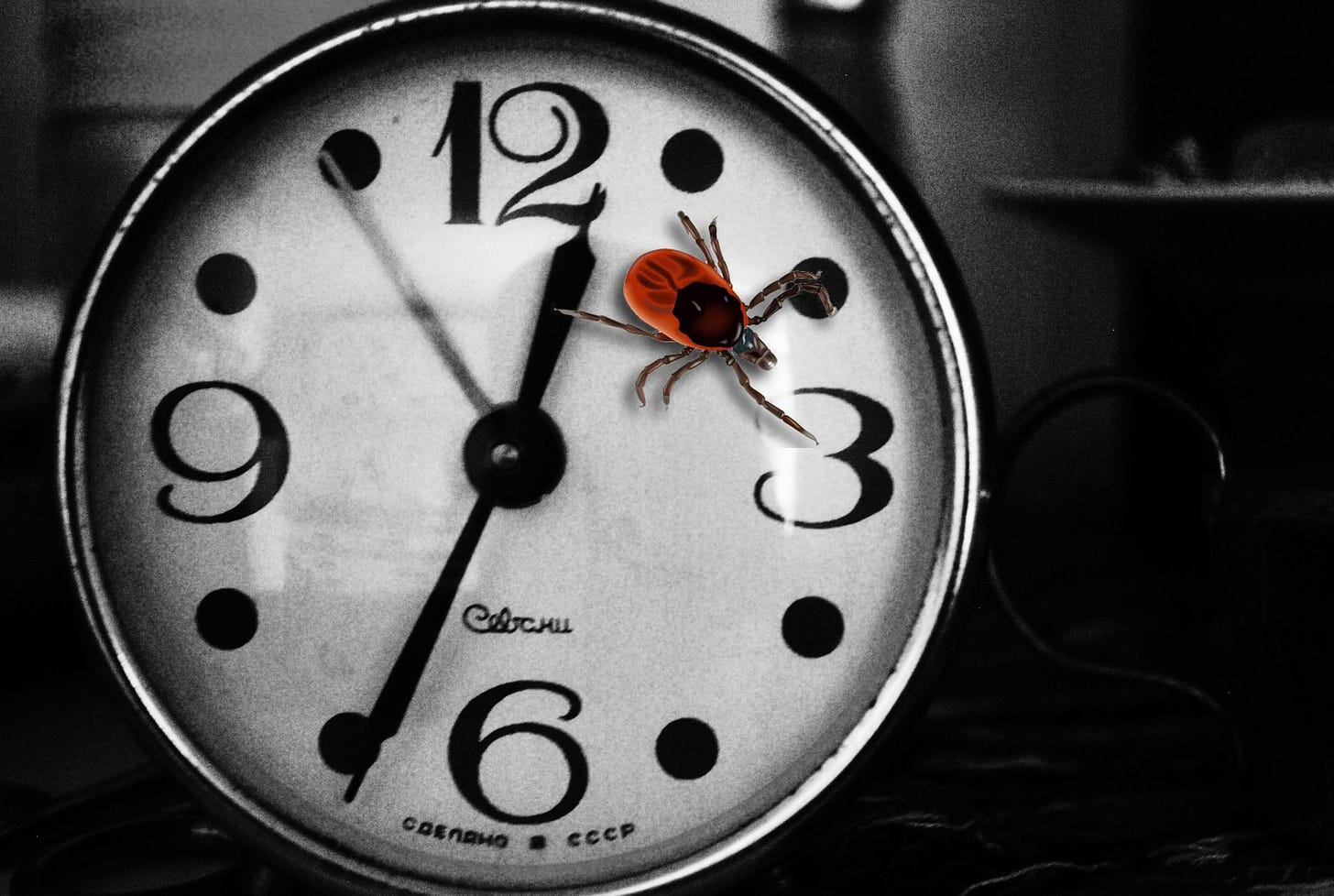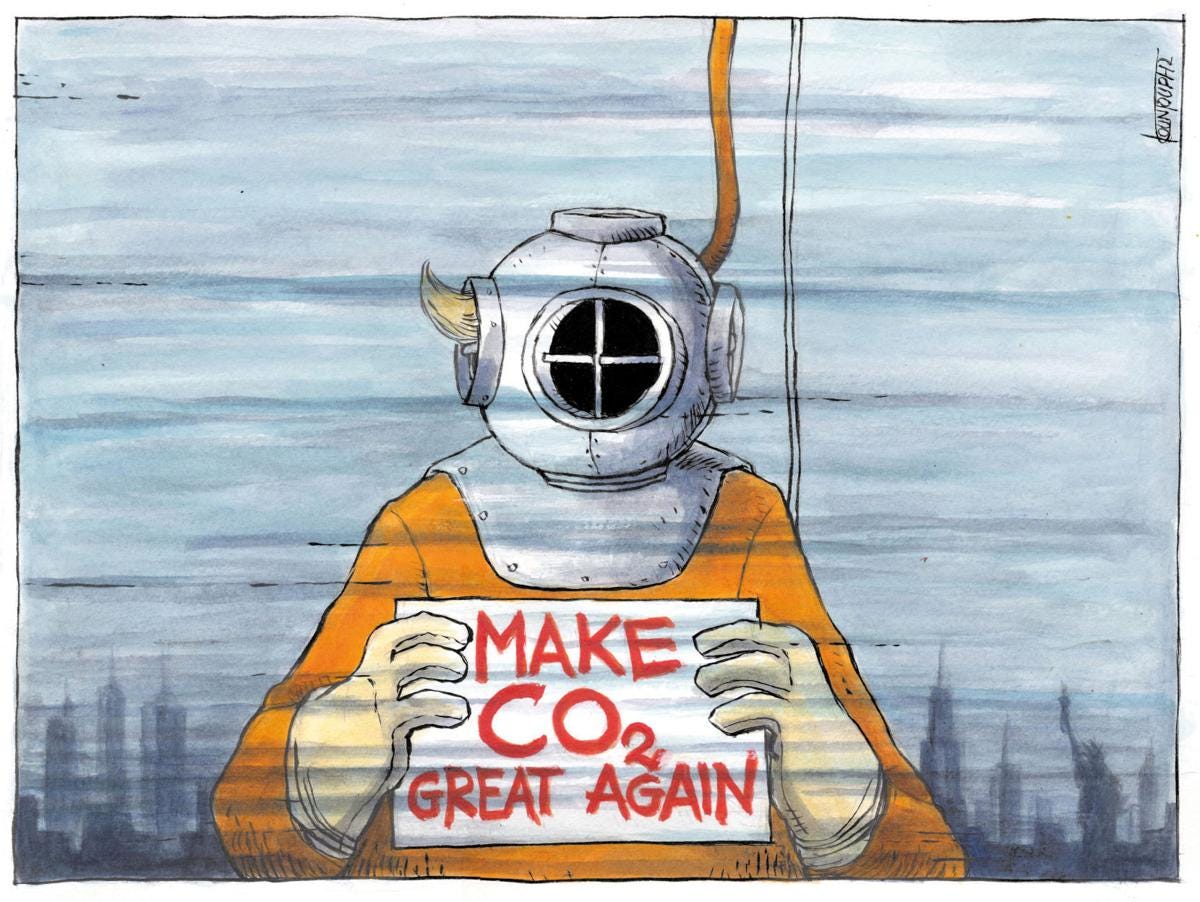The Big & Little of Climate Change
Earth's biggest mountain melts & one of Nature's tiniest bugs looms large | ISSUE 19, 07.02.19
QUICK|READ: Who you gonna trust on the climate crisis? How about a Sherpa who has ascended and descended Mount Everest 21 times? “Less snow and more rocks,” and “glaciers all over the mountain … melting,” he says. | And ‘tick-tick-tick’ is the sound of a pandemic time-bomb of tick-borne disease, fueled by a warming climate. | Plus, the Trump Administration considered as the world’s greatest climate threat (next to its partner in climate-crime, the fossil-fuel industrial complex.) | Subscribe at changingclimatetimes.substack.com. Follow on Twitter at @TimesClimate.
ONE | Chomolungma weeps

View of Mount Everest from Base Camp, Khumjung, Nepal | Martin Jernberg, unsplash.com
What image appears when you hear “sherpa”? Doubtless for many of us, a cinematic image pops into mind. Slight, brown-skinned men nimbly hauling heavy rucksacks, leading folks from around the world with frosted goggles up Mount Everest.
What about this definition of ‘sherpa’: First-person climate change reporter. That’s what came to my mind, reading this New Republic article. In it, a 57-year-old Nepalese man, Apa Sherpa, tells writer Emily Atkin about his 21 ascents of Mount Everest.
His last ascent was in 2011. Even then, after three decade of climbing the great mountain the Nepalese call Sagarmāthā and Tibetans called Chomolungma, Apa saw how it had been transformed by a warming climate:
There are big changes on the mountain from when I first climbed to the last time. There is less snow, and more rocks. There used to be house-sized ice pyramids at basecamp, but now you don’t see that. Back then, we had to melt ice and snow for water at basecamp and at Camp II. Now, you can find streams of water at both places.
In 2008, I noticed that all the glaciers all over the mountain were melting. There were messes of human waste all over the road that came from the ice melt. On the mountain, the human waste is not stinky, because it is very cold. So we brought it down in zip-lock bags and dumped it in barrels in the valley.
If you need one vivid image for the climate crisis, collecting warmed-up climber poop off the planet’s highest hill because we’ve messed up Earth’s operating system might be it. As the climate activist sign puts it: ‘There Is No Planet B!’
PS: Apa stopped climbing when his wife told him to. “You’ve got to listen to whatever your wife says,” he wisely noted. He now runs the Apa Sherpa Foundation, which accepts donations to aid Sherpa communities.
PSS: The word “sherpa” does not mean ‘Helps Westerners Get Up Big Mountain.’ It means ‘people from the east.’ “Sher = East,” and “Pa = people. They’re an ethnic group believed to have immigrated from eastern Tibet about 500 years ago, Apa explains. “Not all Sherpas guide on the mountain. Not all of them should have to.”
TWO | Pithy Climate Tweets


Enough said.
PS: Here’s a good take-down of the climate science denier claim “C02 is good for us!” (Here’s another. And another. And another. Thanks ‘Peter Believes in Science Not Dogma’!)
It seems like a great counter-argument to the fact that carbon dioxide is a dangerous pollutant – a fact that contrarians often dispute. However, reality is far more complicated than the oversimplification of ‘CO2 is plant food.’ Unlike in the controlled environment of a greenhouse, the increasing greenhouse effect on Earth causes temperatures to rise and the climate to change in various ways that can be bad for plant life. We can’t control all the other variables the way we can in a greenhouse.
PSS: Attention #climatetwitter. A new hashtag (spun off this tweet) for busy folk with time to read only 6 words or less: #PithyClimateTweets.
THREE | Tick-tick-tick….

Photo by Petradr (with added tick) | Unsplash.com
Usually, when someone writing on the climate says ‘Tick-tick-tick…’, you assume it’s about how much time remains to address the climate crisis before we’re human toast.
But, no, let’s talk ticks, the multi-threat bugs small as Mount Everest is large. Just like Everest’s melting ice pyramids, a pandemic of debilitating, sometimes deadly, tick-borne diseases looks to be another domino falling from a climate going haywire.
That’s according to Elemental, a science-backed subset of Medium.com. Elemental just published an amazing/alarming/frightening/illuminating/magisterial series with the not-so-subtle title “TICKPOCALYPSE.” (Dear Elemental page designer: Impressive work! But, man, it’s hard to read with icky animated ticks wriggling over the pages. Maybe the point was to freak us out? Did!)
The lead story’s headline sums it up: Lyme Disease Cases Are Exploding. And It’s Only Going to Get Worse: Climate change and human sprawl have triggered a pandemic”:
Thanks to climate change, globalization, and other factors, ticks are not only proliferating but also becoming more malignant, more aggressive, and more likely to carry infection. A public health crisis is hiding in plain sight, with tick-borne diseases creating millions of sick people at an economic cost running into the billions, and little has been done so far to mount a meaningful defense. On every walk in the woods or picnic in the park, we are encountering more ticks. And as Willy Burgdorfer, the entomologist who identified the bacteria that causes Lyme disease, once proclaimed: “There is no such thing as a clean tick.”
Lyme disease is most common in the mid-Atlantic region, Upper Midwest, and Northeast of America. Yet the series notes it has now been found in all 50 states. About 300,000 people are estimated to contract the disease each year in America, a number expected to skyrocket. Tick-bite illnesses are booming globally, too.
And if you thought Lyme Disease, and the even more dangerous tick-borne disease Rocky Mountain Spotted Fever, were only worries for folks in forests, the series will have you thinking—and planning—differently when you head outside. Start with this link for “How to Prevent and Treat Tick Bites and Lyme Disease.”
For readers who don’t click the link, key tips from the series:
Seek ticks in the backs of knees, armpits, behind the ears, groin, scalp, and around the waist including the belly button. Dogs and cats bring ticks home, too.
If you find a tick, get it out quickly, even if you only have fingers. You want it out ASAP as the longer it’s in, the more your exposure to pathogens: A CDC guide.
Clean the bite site with alcohol or soap and water, then apply Neosporin or other antibacterial ointment. Don’t freak. Not all ticks transmit disease.
Ticks start smelling blood any time the temperature rises above freezing. But they’re most likely to bite during spring and summer.
Don’t let ticks keep you from enjoying the Nature we’re all out to preserve. Sticking to wide, sunlit paths is a good way for people and pets to avoid ticks.
Use repellants with DEET, says the CDC. “Natural” repellents with essential oils of garlic, rosemary, and other plants will repel blacklegged ticks, says the EPA.
Wear long pants and tuck into your socks. Once home, remove clothes and dry on high heat for 50 minutes. (Ticks can survive washing and low-heat drying.)
What in the world to do globally? One idea is scary ambitious. Via CRISPER, alter the DNA of white-footed mice (a huge tick vector, equal to the role rats played in the bubonic plague, the series ominously notes). Then, release Lyme-resistant mice into the fields and woods of Nantucket and Martha’s Vineyard, as proof-of-concept.
What could go wrong, right?
PS: I try to avoid overloading readers with uber-alarming climate stories. But the Everest tale and tick series are like bookends: They illustrate how every aspect of Earthly existence is affected by the consequences of an overheating world.
The biggest issue of all—the issue presidential candidate Jay Inslee rightly says includes all others—is to slow down, then stop, how our fossil-fuel powered global economy pours heat into the Earth’s atmosphere and seas. And then keeps it there, triggering a cascade of worldwide, species-killing consequences.
Big as Everest. Small as a tick.
FOUR | What’s It All About, Alfie?
I dunno about this climate communication work. ChangingClimateTimes is a tiny shrub in the sprawling, fast-spreading ecosystem of climate work. (Any other shrubs reading this? Let’s grow together!). First, I give myself an ‘Attaboy!’ for an issue that I think cleverly book-ends Mount Everest and ticks, as harbingers of climate change.
Then, I catch myself: Wait a second! What we’re really talking about is whether my smart-as-a-whip, twenty-something daughter and Electronic Dance Music-maestro son will have a habitable planet to call home—and still be dancing to his songs with joy—when they’re my age.
That’s a buzz-kill. I’d rather work myself out of this part-time, climate newsletter job—by helping in some small way to turn things around. After all is said and done, that’s why us climate shrubs and climate redwoods— and all the other climate flora and fauna, from scientists to activists, moms and pops, to Greta Thunberg and local schoolkids—raise our voices.
If you don’t have kids, bring to mind someone you love, age 40 or less. If you ARE a kid, make sure you get Mom and Dad, grandpa and granddad, uncle and aunt, teacher and friends, out for the global climate strike coming the week of September 20-27.
It’s taking place, like … everywhere on Earth.
Maybe where you live and love. Maybe you’re going to be who helps plan for the strike and other events that unfold that week where you live.
Tune in. Don’t drop out. Check this link for how to mount a local strike: globalclimatestrike.net. And see the video below:
FIVE | Trump As Climate Crisis
Speaking of pithy statements, here’s one from a recent ChangingClimateTimes tweet. I feel it bears repeating: “The Trump administration is the world’s greatest climate change threat, next to the fossil fuel industrial complex.” They’re climate crime gangbangers.


From the story:
"The Trump administration has refused to publicize dozens of government-funded studies that carry warnings about the effects of climate change ... Studies range from a groundbreaking discovery that rice loses vitamins in a carbon-rich environment—a potentially serious health concern for 600 million people world-wide whose diet consists mostly of rice—to a finding that climate change could exacerbate allergy seasons to a warning to farmers about the reduction in quality of grasses important for raising cattle."
PS: I’m a stout fan of Rachel Maddow. I’ve taken issue with the lack of prime real estate on her MSNBC show devoted to climate change. But her July 1, 2019 program led off with a long segment on the Politico story above. The story details how our commander-in-so-called-chief has a full-court press on to bury all climate research by the government Americans pay to protect them and the world from existential threats.
Like climate change. And them.
Way to go, Ms. Maddow.
Keep it coming.
PS | You Promised Cartoons
I did. Help grow the Changing Climate Times. Subscribe for free and read past issues at changingclimatetimes.substack.com. Pass the link forward to your social mediaverse. Feedback and content ideas welcome. Be well | Changing Climate Times Concierge and Curator Douglas John Imbrogno | douglasjohnmartin AT icloud.com
TEAM|WORK: Thanks to David Imbrogno for key editing feedback.



